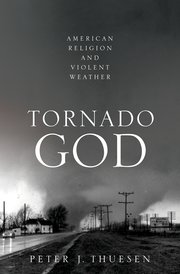Monthly Updates on Recent Books in the History of Christianity
Due to the cancellation of many conferences in the past six months amid the COVID-19 pandemic, many of us have had less opportunity to browse or even see new books coming out in our fields. To raise awareness of recent books in the history of Christianity, the editorial staff of Church History: Studies in Christianity and Culture will be highlighting each month a list of 10-15 books in diverse periods and geographical regions that we hope will be of interest to our members. We include here below the first monthly list, chosen by our staff, with excerpts from the publishers’ blurbs. These books will also be featured on our social media accounts in groups of two or three per week.
Peter J. Thuesen, Tornado God: American Religion and Violent Weather. 2020
One of the earliest sources of humanity's religious impulse was severe weather, which ancient peoples attributed to the wrath of storm gods. Enlightenment thinkers derided such beliefs as superstition and predicted they would pass away as humans became more scientifically and theologically sophisticated. But in America, scientific and theological hubris came face-to-face
with the tornado, nature's most violent windstorm. Striking the United States more than any other nation, tornadoes have consistently defied scientists' efforts to unlock their secrets. Meteorologists now acknowledge that even the most powerful computers will likely never be
able to predict a tornado's precise path.
Similarly, tornadoes have repeatedly brought Americans to the outer limits of theology, drawing them into the vortex of such mysteries as how to reconcile suffering with a loving God and whether there is underlying purpose or randomness in the universe. In this groundbreaking history, Peter Thuesen captures the harrowing drama of tornadoes, as clergy, theologians, meteorologists, and ordinary citizens struggle to make sense of these death-dealing tempests.
See publisher's website here.

Mattias P. Gassman, Worshippers of the Gods: Debating Paganism in the Fourth-Century Roman West. 2020
Worshippers of the Gods tells how the Latin writers who witnessed the political and social rise of Christianity rethought the role of traditional religion in the empire and city of Rome. In parallel with the empire's legal Christianisation, it traces changing attitudes toward paganism from the last empire-wide persecution of Christians under the Tetrarchy to the removal of state funds from the Roman cults in the early 380s. Influential recent scholarship has seen Christian polemical literature-a crucial body of evidence for late antique polytheism-as an exercise in Christian identity-making. In response, Worshippers of the Gods argues that Lactantius, Firmicus Maternus, Ambrosiaster, and Ambrose offered substantive critiques of traditional religion shaped to their political circumstances and to the preoccupations of contemporary polytheists. By bringing together this polemical literature with imperial laws, pagan inscriptions, and the letters and papers of the senator Symmachus, Worshippers of the Gods reveals the changing horizons of Roman thought on traditional religion in the fourth century.
See publisher's website here.
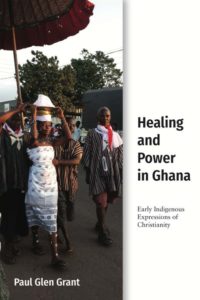
Paul Glen Grant, Healing and Power in Ghana: Early Indigenous Expressions of Christianity. 2020
In nineteenth-century Ghana, regional warfare rooted in profound social and economic transformations led thousands of displaced people to seek refuge in the small mountain kingdom of Akuapem. There they encountered missionaries from Germany whose message of sin and forgiveness struck many of these newcomers as irrelevant to their needs. However, together with Akuapem’s natives, these newcomers began reformulating Christianity as a ritual tool for social and physical healing, as well as power, in a dangerous spiritual and human world. The result was Ghana’s oldest African-initiated variant of Christianity: a homegrown expression of unbroken moral, political, and religious priorities.
Focusing on the southeastern Gold Coast in the middle of the nineteenth century, Healing and Power in Ghana identifies patterns of indigenous reception, rejection, and reformulation of what had initially arrived, centuries earlier, as a European trade religion. Paul Grant draws on a mixture of European and indigenous sources in several languages, building on recent scholarship in world Christianity to address the question of conversion through the lens of the indigenous moral imagination. This approach considers, among other things, the conditions in which Akuapem locals and newly arrived displaced persons might find Christianity useful or applicable to their needs.
See publisher's website here.
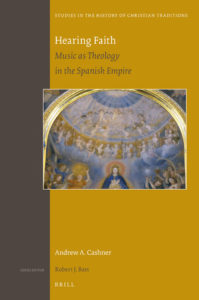
Andrew A. Cashner, Hearing Faith: Music as Theology in the Spanish Empire. 2020
Hearing Faith explores the ways Roman Catholics in the seventeenth-century Spanish Empire used music to connect faith and hearing. From the Royal Chapel in Madrid to Puebla Cathedral in colonial Mexico, communities celebrated Christmas and other feasts with villancicos, a widespread genre of vernacular poetry and devotional music. A large proportion of villancico texts directly address the nature of hearing and the power of music to connect people to God. By interpreting complex and fascinating examples of “music about music” in the context of contemporary theological writing, the book shows how Spanish Catholics embodied their beliefs about music, through music itself. Listening closely to these previously undiscovered and overlooked archival sources reveals how Spanish subjects listened and why.
See publisher's website here.
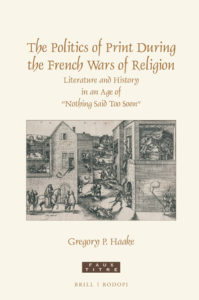
Gregory P. Haake. The Politics of Print During the French Wars of Religion: Literature and History in an Age of “Nothing Said Too Soon.” 2020
In The Politics of Print During the French Wars of Religion, Gregory Haake examines how, in late sixteenth-century France, authors and publishers used the new medium of the printed text to control the terms of public discourse and determine history, or at least their narrative of it.
The creativity of the Renaissance ushered in new instability of discourse and a decline of traditional centres of authority. Gregory Haake shows that poets, authors, printers, and polemicists — including historians, such as Simon Goulart; the great poets of the time, such as Pierre de Ronsard or Agrippa d’Aubigné; or anonymous authors of polemical texts — rushed in to take advantage of discursive uncertainty to discredit their enemies and shape the meaning of history as it unfolded.
See publisher's website here.
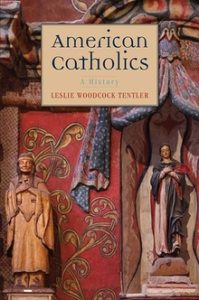
Leslie Woodcock Tentler, American Catholics: A History. 2020
This comprehensive survey of Catholic history in what became the United States spans nearly five hundred years, from the arrival of the first Spanish missionaries to the present. Distinguished historian Leslie Tentler explores lay religious practice and the impact of clergy on Catholic life and culture as she seeks to answer the question, What did it mean to be a “good Catholic” at particular times and in particular places?
In its focus on Catholics’ participation in American politics and Catholic intellectual life, this book includes in-depth discussions of Catholics, race, and the Civil War; Catholics and public life in the twentieth century; and Catholic education and intellectual life. Shedding light on topics of recent interest such as the role of Catholic women in parish and community life, Catholic reproductive ethics regarding birth control, and the Catholic church sex-abuse crisis, this engaging history provides an up-to-date account of the history of American Catholicism.
See publisher's website here.
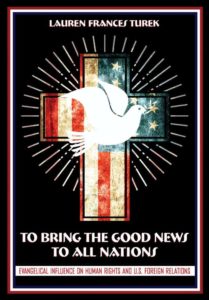
Lauren Frances Turek, To Bring the Good News to All Nations: Evangelical Influence on Human Rights and U.S. Foreign Relations. 2020
When American evangelicals flocked to Latin America, Africa, Asia, and Eastern Europe in the late twentieth century to fulfill their Biblical mandate for global evangelism, their experiences abroad led them to engage more deeply in foreign policy activism at home. Lauren Frances Turek tracks these trends and illuminates the complex and significant ways in which religion shaped America's role in the late–Cold War world. In To Bring the Good News to All Nations, she examines the growth and influence of Christian foreign policy lobbying groups in the United States beginning in the 1970s, assesses the effectiveness of Christian efforts to attain foreign aid for favored regimes, and considers how those same groups promoted the imposition of economic and diplomatic sanctions on those nations that stifled evangelism.
See publisher's website here.

Heather L. Bailey, The Public Image of Eastern Orthodoxy: France and Russia, 1848-1870. 2020
Focusing on the period between the revolutions of 1848-1849 and the First Vatican Council (1869-1870), The Public Image of Eastern Orthodoxy explores the circumstances under which westerners, concerned about the fate of the papacy, the Ottoman Empire, Poland, and Russian imperial power, began to conflate the Russian Orthodox Church with the state and to portray the Church as the political tool of despotic tsars.
As Heather L. Bailey demonstrates, in response to this reductionist view, Russian Orthodox publicists launched a public relations campaign in the West, especially in France, in the 1850s and 1860s. The linchpin of their campaign was the building of the impressive Saint Alexander Nevsky Church in Paris, consecrated in 1861. Bailey posits that, as the embodiment of the belief that Russia had a great historical purpose inextricably tied to Orthodoxy, the Paris church both reflected and contributed to the rise of religious nationalism in Russia that followed the Crimean War. At the same time, the confrontation with westerners' negative ideas about the Eastern Church fueled a reformist spirit in Russia while contributing to a better understanding of Eastern Orthodoxy in the West.
See publisher's website here.

James Bernauer, S.J., Jesuit Kaddish: Jesuits, Jews, and Holocaust Remembrance. 2020
University of Notre Dame Press
While much has been written about the Catholic Church and the Holocaust, little has been published about the hostile role of priests, in particular Jesuits, toward Jews and Judaism. Jesuit Kaddish is a long overdue study that looks at Jesuit hostility toward Judaism before the Shoah, and then examines the development of a new understanding of the Catholic Church’s relation to Judaism that culminated with Vatican II’s landmark decree Nostra aetate. James Bernauer’s study is historically accurate and spiritually ambitious in its desire to have this story of the Jesuits’ relation to Jews and Judaism contribute to interreligious reconciliation.
See publisher's website here.

Rebecca Stephens Falcasantos, Constantinople: Ritual, Violence, and Memory in the Making of a Christian Imperial Capital. 2020
University of California Press
As Christian spaces and agents assumed prominent positions in civic life, the end of the long span of the fourth century was marked by large-scale religious change. Churches had overtaken once-thriving pagan temples, old civic priesthoods were replaced by prominent bishops, and the rituals of the city were directed toward the Christian God. Such changes were particularly pronounced in the newly established city of Constantinople, where elites from various groups contended to control civic and imperial religion.
Rebecca Stephens Falcasantos argues that imperial Christianity was in fact a manifestation of traditional Roman religious structures. In particular, she explores how deeply established habits of ritual engagement in shared social spaces—ones that resonated with imperial ideology and appealed to the memories of previous generations—constructed meaning to create a new imperial religious identity. By examining three dynamics—ritual performance, rhetoric around violence, and the preservation and curation of civic memory—she distinguishes the role of Christian practice in transforming the civic and cultic landscapes of the late antique polis.
See publisher's website here.
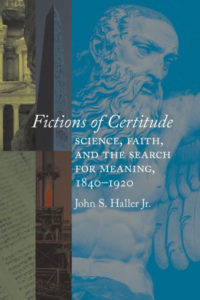
John S. Haller Jr., Fictions of Certitude: Science, Faith, and the Search for Meaning, 1840-1920. 2020
The nineteenth century’s explosion of scientific theories and new technologies undermined many deep-seated beliefs that had long formed the basis of Western society, making it impossible for many to retain the unconditional faith of their forebears. A myriad of discoveries—including Faraday’s electromagnetic induction, Joule’s law of conservation of energy, Pasteur’s germ theory, Darwin’s and Wallace’s theories of evolution by natural selection, and Planck’s work on quantum theory—shattered conventional understandings of the world that had been dictated by traditional religious teachings and philosophical systems for centuries.
Fictions of Certitude: Science, Faith, and the Search for Meaning, 1840–1920 investigates the fin de siècle search for truth and meaning in a world that had been radically transformed. John S. Haller Jr. examines the moral and philosophical journeys of nine European and American intellectuals who sought deeper understanding amid such paradigmatic upheaval.
See publisher's website here.

Hillary Kaell, Christian Globalism at Home: Child Sponsorship in the United States. 2020
Child sponsorship emerged from nineteenth-century Protestant missions to become one of today’s most profitable private fund-raising tools in organizations including World Vision, Compassion International, and ChildFund. Investigating two centuries of sponsorship and its related practices in American living rooms, churches, and shopping malls, Christian Globalism at Home reveals the myriad ways that Christians who don’t travel outside of the United States cultivate global sensibilities.
Kaell traces the movement of money, letters, and images, along with a wide array of sponsorship’s lesser-known embodied and aesthetic techniques, such as playacting, hymn singing, eating, and fasting. She shows how, through this process, U.S. Christians attempt to hone globalism of a particular sort by oscillating between the sensory experiences of a God’s eye view and the intimacy of human relatedness. These global aspirations are buoyed by grand hopes and subject to intractable limitations, since they so often rely on the inequities they claim to redress.
See publisher's website here.
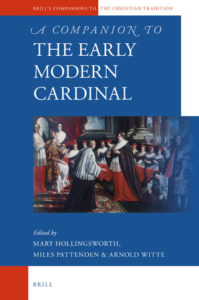
Mary Hollingsworth, Miles Pattenden, and Arnold Witte, eds., A Companion to the Early Modern Cardinal. 2020
A Companion to the Early Modern Cardinal is the first comprehensive overview of its subject in English or any language. Cardinals are best known as the pope’s electors, but in the centuries from 1400 to 1800 they were so much more: pastors, inquisitors, diplomats, bureaucrats, statesmen, saints; entrepreneurs and investors; patrons of the arts, of music, literature, and science. Thirty-five essays explain their social background, positions and roles in Rome and beyond, and what they meant for wider society. This volume shows the impact which those men who took up the purple had in their respective fields and how their tenure of office shaped the entangled histories of Rome and the Catholic Church from a European and global perspective.
See publisher's website here.
Finally, for staying up-to-date on the latest titles in all fields, we recommend regularly perusing New Books Network, and will regularly link to its “New Books in Christian Studies” page here. These pages are updated regularly.

